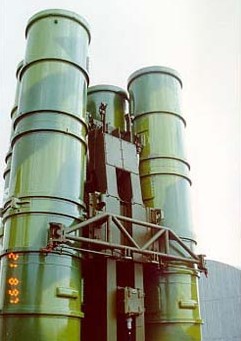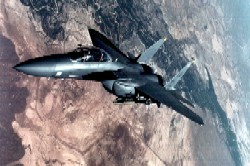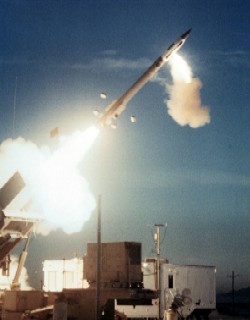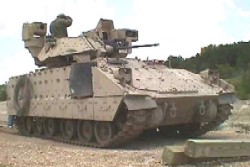Page 1
Daily News
By Gail Helmer
| Send Us News | Archives | Main |
Wednesday, May 30, 2001
- E3 Coverage Continued
- Return to Castle Wolfenstein Screens
- Soldier of Fortune II Screens
- Star Trek Bridge Commander Screens
- Star Trek Armada II Screens
- Bush Set To Buy Russian Defense Systems
- Royal Saudi Air Force Orders Boeing F-15C
- PAC-3 Missile Wins Prestigious Daedalian's Award
- DRS Technologies Awarded IBAS Contract
PC News
E3 Coverage Continued
Activision showcased a blockbuster E3 lineup which included Return to Castle Wolfenstein, the follow up to id Software's classic hit Wolfenstein 3D; Soldier of Fortune 2, the sequel to, Soldier of Fortune; and two titles based on the Star Trek franchise - Star Trek Bridge Commander and Star Trek Armada II.
Return to Castle Wolfenstein Screens
Return to Castle Wolfenstein uncovers Hitler's horrifying obsession with the occult, living dead, and genetic mutations. As B.J. Blaskowitz, an Army Ranger recruited into the Office of Secret Actions (OSA), players infiltrate deep into the twisted bowels of the Third Reich to battle the horrific super-soldiers, zombies and mutants forged in the unearthly experiments of Heinrich Himmler. Built on the powerful QUAKE III Arena™ engine, Return to Castle Wolfenstein delivers fast-paced action and white-knuckle suspense. The game is being developed by Gray Matter Interactive Studios in conjunction with id Software. Release Date: Fall 2001.
Soldier of Fortune II Screens
The sequel to the first-person action from 2000, Soldier of Fortune II Double Helix is powered by QUAKE III Arena graphics. Featuring advanced artificial intelligence and real-world weaponry, enemies and military devices, the game puts players in the role of John Mullins a military consultant working for the top-secret anti-terrorist group known only as The Shop. As Mullins, players must tackle a wide-range of missions from hostage rescue and intelligence gathering to search-and-destroy. Additionally, in order to complete their objectives, players will make use of a variety of gameplay tactics ranging from full frontal assaults to stealth and subterfuge. Soldier of Fortune II Double Helix is being developed by Raven Software. Release Date: Winter 2001.
Star Trek Bridge Commander Screens
Star Trek Bridge Commander is the first space simulation ever to put gamers on the bridge as the captain of a Galaxy or Sovereign-class starship. Gamers will be able to control the action directly in a fully immersive tactical mode or by issuing commands to their crew while viewing the action from the bridge. The game will feature a variety of challenging missions compelling starship combat, cameo appearances by Captain Picard and Commander Data, and a multiplayer option that will give gamers the chance to command any ship in the game. Star Trek Bridge Commander is being developed for Activision by Lawrence Holland's Totally Games. . Release Date: Summer 2001.
Star Trek Armada II Screens
Star Trek Armada II is an innovative RTS, the game adds a new level of strategy and realism to the original by allowing players to command from a 3D tactical view. Set in The Next Generation universe, Star Trek Armada II's story unfolds through three single-player campaigns played as the Federation, Klingons and Borg. Additionally, the Cardassians, Romulans and Species 8472 will join the fray throughout the single-player campaigns. Star Trek Armada II also features an extensive range of multiplayer options, including up to eight player competitions over LAN and the Internet via GameSpy. The game is being developed for Activision by Mad Doc Software. Release Date: Fall 2001.
Military News
Bush Set To Buy Russian Defense Systems
The US is considering a move to purchase Russian built S-300 missiles in an effort to sweeten the pill of President Bush's moves to annul the effects of the 1972 Anti-ballistic Missile Treaty (ABM). The President's initiative, announced earlier this year, to create a new missile defence system met with a lukewarm reception worldwide, and sparked fears that it could represent the beginning of a new arms race.
In a move first reported by the New York Times on Monday, the White House is proposing to involve other nations, including Russia, in the development of missile defence systems for Europe so as to gain support for the abandonment of the ABM Treaty. President Bush is expected to put detailed proposals to Russian Premier Vladimir Putin including the possible purchase of the S-300 missiles designed to destroy fast moving aircraft and missiles.
"We want to convince the Russians that it is in their best interest to move beyond the ABM treaty and to develop a new relationship with us," National Security Adviser Condoleezza Rice told the New York Times.
The Russian government has denied receiving any official proposals regarding this story. Furthermore, it seems likely that any offer to buy missiles will be treated as a separate issue by the Russians.
"If such proposals come - we have not yet received them - I am sure that they will not solve the ABM issue. The S-300 missile is a tactical air-defence, not anti-missile, weapon. Russia has sold these missiles to many countries. I cannot link this issue with ABM plans," said Russian Defence Minister Sergei Ivanov at a press conference.
Whether Russia is receptive of US advances or not, the White House proposals still represent a considerable softening from the gung ho position adopted by President Bush when he announced his defence system plans, dubbed "Son of Star Wars". The reasons for this could be twofold. Firstly, the defection of Senator Jim Jeffords of Vermont from the Republican Party means a Democrat controlled Senate. With Democrats presiding over key defence committees, any plans for building extensive missile defence systems are likely to be scrutinised assiduously. Secondly, the threat to the lifespan of the ABM Treaty, which has proved the basis for numerous other agreements, has led to defence liaisons between Russia and China.
In any event, what seems assured is that for President Bush to receive global support for his controversial defence policy, the US must first achieve an understanding with Moscow.
Royal Saudi Air Force Orders Boeing F-15C
The Boeing Company booked the first international sale of its F-15C Distributed Mission Training (DMT) system when it recently signed a foreign military sales contract to provide DMT systems to the Royal Saudi Air Force. The contract has an approximate value of $50 million plus options.
Based on the successful U.S. Air Force F-15C DMT systems, which currently equip Mission Training Centers at Eglin Air Force Base, Fla., and Langley Air Force Base, Va., the systems for the Royal Saudi Air Force will provide effective squadron-level training at three separate Royal Saudi Air Force bases.
Each base will receive two full-fidelity aircrew training devices. The aircrew trainers are networked to allow two pilots to "fly" together, providing realistic mission rehearsal and proficiency training.
The systems also include the Boeing-developed 360-degree Visual Integrated Display System (VIDS), the Boeing BigTac combat environment server, desktop trainers, local networking environment and contractor logistics support.
Delivery of the systems is scheduled for the second quarter of 2003.
"These devices combine the highest levels of realism, reliability and affordability for extraordinarily effective mission training," said Keith Hertzenberg, vice president and general manager of Training Systems and Services, part of the Boeing Military Aerospace Support business. "I'm confident the Royal Saudi Air Force will realize the same "train as you fight" benefits as the U.S. Air Force has through the F-15C Mission Training Centers."
PAC-3 Missile Wins Prestigious Daedalian's Award
The Patriot Advanced Capability (PAC-3) Missile, produced by Lockheed Martin Missiles and Fire Control, has won the Daedalian's Weapons System Award, the Colonel Franklin C. Wolfe Memorial Trophy for 2000. The award was presented at the annual Daedalian Convention on May 23, 2001, in Las Vegas, N.V.
The Daedalian's trophy is presented annual to individuals, groups or organizations judged to have contributed the most outstanding weapons system development which operates, in whole or in part, in the aerospace environment. The recipients are selected by the individual services from nominations submitted by the Department of the Army, the Navy, and the Air Force, and the award is made on a rotational basis and in that order.
The donor of this trophy, the late Colonel Franklin C. Wolfe, served as Assistant Chief and then Chief of the Armament Laboratory of the Army Air Forces Materiel Command at Wright Field, Ohio, from 1939 until his retirement in 1944.
This significant honor is a tribute to the fine men and women of the combined government/industry team responsible for the many successes associated with the PAC-3 ground system and PAC-3 missile.
In February 2000, the PAC-3 Missile won the Aerospace Industry Award 2000 for the Space and Missiles category. Flight International magazine sponsored that competition. Lockheed Martin Missiles and Fire Control's Orlando-based unit won the Daedalian's Award in 1997 for the Longbow Hellfire Anti-Tank Missile Systems, in 1994 for the Javelin Anti-Tank Missile Project, and in 1987 for the Low Altitude Navigation & Targeting Infrared for Night Systems (LANTIRN) program.
Lockheed Martin Missiles and Fire Control is the prime contractor responsible for the PAC-3 Missile segment upgrade to the Patriot air defense system, which consists of the PAC-3 Missile, the missile canisters, the Fire Solution Computer and the Enhanced Launcher Electronics System.
The PAC-3 Missile has now had nine consecutive successful engineering and manufacturing development (EMD) test flights since 1997. The first two EMD missions were successfully conducted with special instrumentation packages in place of the full-up PAC-3 Missile seeker. The missions were structured to verify critical systems and missile performance prior to conducting target intercept flight tests.
The first PAC-3 Missile target intercept flight was on March 15, 1999. The second followed on September 16, 1999, with the third intercept of a TBM on February 5, 2000. Two successful cruise missile intercepts, on July 22 and 28, 2000, proved conclusively the PAC-3 Missile's ability to detect and destroy low-flying cruise missiles. The sixth successful intercept occurred on October 14, 2000, when the PAC-3 Missile intercepted and destroyed an incoming TBM target. The seventh intercept was on March 31, 2001, when a PAC-3 destroyed another TBM target.
The PAC-3 Missile entered Low-Rate Initial Production (LRIP) in December 1999, with two follow-on LRIP contract in calendar year 2000. Several contracts for special hardware and long lead-time items have also been awarded to Lockheed Martin Missiles and Fire Control since the beginning of the LRIP phase of the program. Initial fielding of the PAC-3 Missile is planned for later this year.
In addition to the nine successful PAC-3 Missile flight tests, the PAC-3's predecessor missile, the Extended-Range Interceptor, demonstrated three hits in a row during the demonstration/validation program in 1994. Two of those tests involved TBM targets and one involved an air-breathing target (simulating a cruise missile or aircraft).
The PAC-3 Missile is a high velocity, hit-to-kill missile and is the next generation Patriot missile being developed to provide increased capability against advanced theater ballistic missile, cruise missile and hostile aircraft. The PAC-3 Missile kills incoming targets by direct, body-to-body impact. The PAC-3 Missiles, when deployed in a Patriot battery, will significantly increase the Patriot system's firepower, since 16 PAC-3 Missiles load-out on a Patriot launcher, compared with four of the old Patriot missiles.
DRS Technologies Awarded IBAS Contract
DRS Technologies has been awarded a multi-year $86.2 million contract from the US Army on the Improved Bradley Acquisition Subsystem (IBAS) programme for the new M2A3 Bradley Fighting Vehicles (BVS). Initial funding is valued at $27.4 million.
IBAS provides important enhancements to the M2A3 Bradley ground platform, including the incorporation of Horizontal Technology Integration (HTI) Second Generation Forward Looking Infrared (FLIR) technology.
IBAS allows the BVS's gunner to detect, identify and engage tactical targets at increased operational ranges. System improvements also provide enhanced shoot-on-the-move capability for the Bradley 25mm gun. IBAS incorporates direct view optics, dual-aided target tracking capability, eyesafe laser range finder capability, a daylight television, and a two-axis, stabilised pointing head mirror assembly.
"The leading edge sighting system technologies we incorporate in IBAS are critical to the upgrade of the Bradley, and provide increased target acquisition performance, greater stand-off ranges and improved survivability for our ground forces. Central components to the Army's HTI initiative, IBAS will continue to have a crucial role in the digital battlefield of the 21st century,'' said Mark S. Newman, chairman, president and chief executive officer of DRS Technologies.
The company's DRS Optronics unit in Palm Bay, Florida, will produce and deliver the IBAS fire control systems required for this contract at its newly expanded, electro-optical design, production and system integration facilities specifically equipped for advanced electro-optical system development, production, test and integration. Product deliveries for this new order are expected to commence in April 2002 and conclude in March 2005.
| Send Us News | Archives | Main |




























